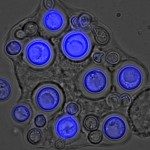Link to Pubmed [PMID] – 11283285
Microbiology (Reading, Engl.) 2001 Apr;147(Pt 4):891-907
Amplified fragment length polymorphism (AFLP) genotyping of isolates of the pathogenic fungus Cryptococcus neoformans suggested a considerable genetic divergence between the varieties C. neoformans var. neoformans and C. neoformans var. grubii on the one hand versus C. neoformans var. gattii on the other. This divergence is supported by additional phenotypic, biochemical, clinical and molecular differences. Therefore, the authors propose the existence of two species, C. neoformans (Sanfelice) Vuillemin and C. bacillisporus Kwon-Chung, which differ in geographical distribution, serotypes and ecological origin. Within each species three AFLP genotypes occur, which differ in geographical distribution and serotypes. Differences in ecological origin (AIDS patients, non-AIDS patients, animals or the environment) were found to be statistically not significant. In C. neoformans as well as in C. bacillisporus one of the genotypes represented a hybrid. The occurrence of hybridization has consequences for the reproductive biology of the species, as new genotypes with altered virulence or susceptibility to antifungal drugs may arise through the exchange of genetic material.

